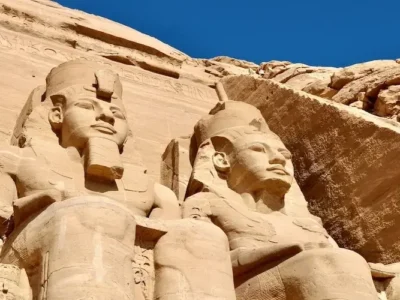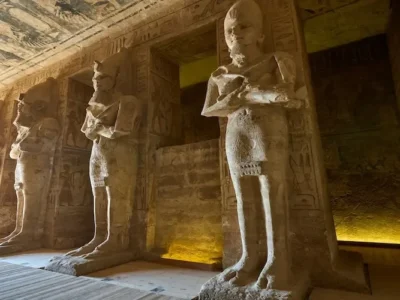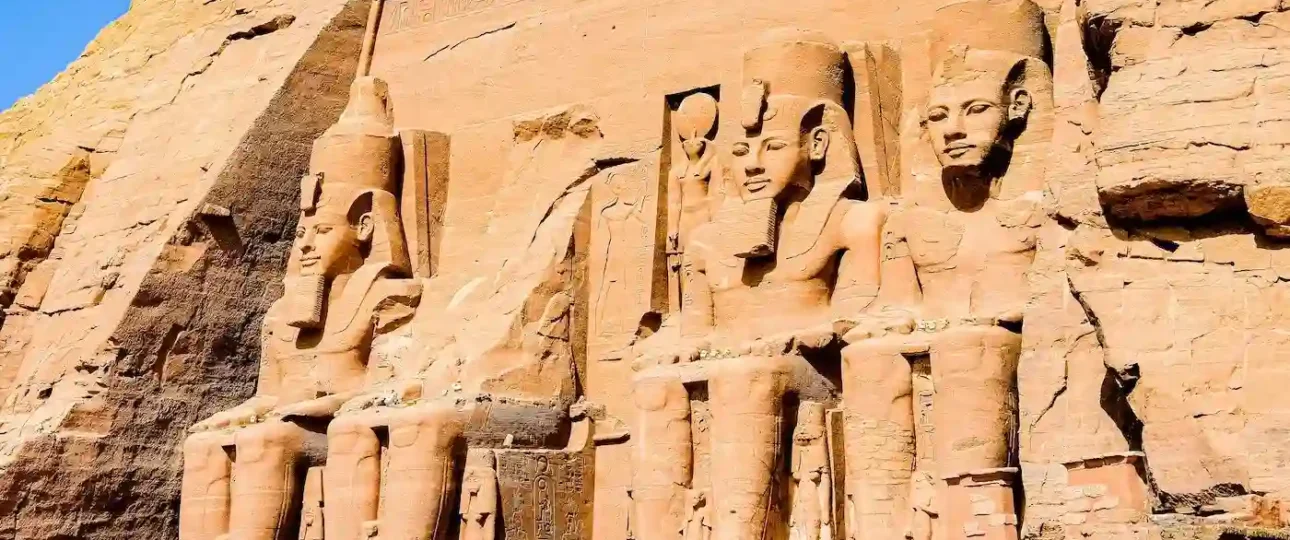Journey through history inside Abu Simbel Temple
Abu Simbel, a monumental temple complex carved into Egypt’s sandstone cliffs over 3,200 years ago, stands as one of humanity’s most extraordinary achievements. Built by Pharaoh Ramesses II to immortalize his power and devotion to the gods, this UNESCO World Heritage Site continues to captivate historians and travelers alike. From its celestial alignments to its daring 20th-century relocation, Abu Simbel’s story blends ancient ambition with modern ingenuity—and is often included in unforgettable journeys like a Nile cruise. This article delves into its architectural brilliance, forgotten secrets, and the global effort that saved it from vanishing beneath Lake Nasser.
Historical and Architectural Significance
Abu Simbel’s twin temples are masterpieces of the New Kingdom era, reflecting Ramesses II’s obsession with legacy. Constructed around 1264 BCE, the complex served dual purposes: as a spiritual sanctuary and a political statement to Egypt’s southern neighbors. The larger temple, dedicated to deities Amun-Re, Re-Horakhty, and Ptah, features four 20-meter-tall statues of Ramesses II. The smaller temple honors Queen Nefertari and Hathor, breaking tradition by depicting a queen at pharaonic scale.
The temples’ strategic location near Nubia (modern-day Sudan) symbolized Egypt’s dominance. Ramesses II aimed to intimidate potential invaders while asserting his divine status. Hieroglyphics inside depict his “victory” at the Battle of Kadesh—a propagandistic blend of art and history.
Beyond grandeur, Abu Simbel’s precision reveals advanced astronomical knowledge. The Great Temple’s inner sanctum aligns with the sun twice yearly, illuminating statues of Ramesses and two gods while leaving Ptah—the god of darkness—in shadow. This alignment, tied to the pharaoh’s birthday and coronation, underscores ancient Egypt’s fusion of science and spirituality.
A Monument to Power and Divinity
Ramesses II designed Abu Simbel to echo eternity. The Great Temple’s façade, dominated by his colossal statues, was strategically angled so sunlight would flood the innermost chamber at dawn. This solar spectacle reinforced his image as a living god, a ruler whose authority transcended mortal limits.

Inside, intricate reliefs depict Ramesses II’s military campaigns, notably the Battle of Kadesh. Though historians argue the battle was a stalemate, the carvings portray him as an invincible hero. Such imagery served dual purposes: to awe worshippers and dissuade Nubian rebellions.
The temple’s layout also mirrors traditional Egyptian cosmology. The three chambers decrease in height from the entrance to the sanctuary, symbolizing the journey from the mortal world to the divine. This architectural hierarchy emphasized the pharaoh’s role as humanity’s intermediary to the gods.
The Smaller Temple for Nefertari
While Ramesses II’s temple dominates attention, the nearby Hathor Temple celebrates Queen Nefertari, his beloved wife. Its façade features six 10-meter-tall statues: four of Ramesses and two of Nefertari, unusually depicted at equal height. This parity was unprecedented, reflecting her unparalleled influence.
Inside, vibrant carvings show Nefertari alongside Hathor, the goddess of love and music. Scenes of the queen making offerings highlight her religious role, while softer, curved columns contrast with the Great Temple’s angular grandeur.
Historians speculate Nefertari’s temple also served diplomatic purposes. By honoring a Nubian-associated goddess (Hathor), Ramesses II may have sought to reconcile Egyptian rule with Nubian traditions, easing tensions in this contested region.
Alignment with the Sun
Abu Simbel’s solar alignment remains one of its most mesmerizing features. Originally, sunlight penetrated 60 meters into the Great Temple on February 21 and October 21, illuminating Ramesses II’s statue. After relocation, this event shifted to February 22 and October 22—a one-day discrepancy caused by the temple’s new latitude.
Engineers meticulously preserved the alignment during the 1960s relocation. Using original blueprints and astronomical charts, they ensured the sun’s rays still reached the inner sanctuary, albeit with a modern adjustment. This precision underscores the ancient builders’ sophistication.
The phenomenon draws thousands annually. At dawn, sunlight gradually lights the statues of Amun-Re, Re-Horakhty, and Ramesses II, a 20-minute spectacle symbolizing the pharaoh’s eternal rebirth. Ptah, ever shrouded in shadow, remains a reminder of the mysteries beyond human reach.
Rediscovery After Centuries
Buried under desert sands for centuries, Abu Simbel was forgotten until 1813, when Swiss explorer Jean-Louis Burckhardt stumbled upon its partially exposed statues. He noted, “Their faces wore a smile of benevolent grandeur.”

Italian adventurer Giovanni Belzoni began excavations in 1817, but shifting sands and logistical challenges delayed full exposure until the late 19th century. Early explorers marveled at the temples’ preservation, with colors on reliefs still vivid despite millennia of isolation.
The site’s remoteness protected it from looting, leaving artifacts intact. Today, visitors retrace Burckhardt’s steps, often arriving at dawn to witness the temples emerge from darkness—a sight unchanged since antiquity.
Relocation: A Modern Engineering Feat
When the Aswan High Dam’s construction threatened to submerge Abu Simbel in the 1960s, UNESCO launched a $40 million rescue mission—an event often highlighted in cultural trips and Nile cruise itineraries. Engineers from 50 countries collaborated to dismantle the temples into 1,042 blocks, each weighing up to 30 tons.
Reassembling the temples 65 meters higher required building an artificial mountain with concrete domes. To maintain authenticity, the new site mirrored the original orientation, and gaps between blocks were filled with mortar matching the sandstone’s hue.
The project took four years (1964–1968) and set new standards for heritage preservation. As engineer Giorgio Croci noted, “We didn’t just move stones; we safeguarded humanity’s memory.”
Forgotten Genius Loci
Abu Simbel’s isolated location was deliberate. Positioned far from Egypt’s heartland, it marked the southern frontier, a spiritual “gate” between Egypt and Nubia. The temples’ scale aimed to overawe Nubian travelers, reinforcing Egyptian supremacy.
Recent studies suggest the site may align with ancient trade routes. Its placement near the Nile’s Second Cataract—a natural border—allowed Ramesses II to control commerce while projecting divine authority.
Today, Lake Nasser’s waters lap near the relocated site, altering its original context. Yet, the temples retain their aura, a testament to how place and power intertwine.
Hidden Structural Resilience
Post-relocation studies reveal surprising durability. The artificial hill’s concrete dome can withstand earthquakes up to magnitude 7.0, while internal steel frameworks prevent subsidence. Ancient builders unknowingly chose sandstone stable enough for modern engineering.
Laser scans show minimal stress on the structure decades after relocation. “It’s as if Ramesses himself blessed the move,” joked one archaeologist. This resilience ensures Abu Simbel will endure for millennia.
Digital Preservation
In 2020, 3D laser scanning captured Abu Simbel’s every detail, creating a digital twin for conservation. These models help monitor erosion and offer virtual access, democratizing a site once reachable only by intrepid travelers.
Augmented reality apps now let users explore hieroglyphics in interactive detail, revealing stories of gods and pharaohs. Such innovations ensure Abu Simbel’s legacy evolves with technology.
Philatelic Legacy
UNESCO’s rescue campaign inspired 47 countries to issue commemorative stamps between 1960–1980. These stamps, featuring Abu Simbel’s statues, raised millions and symbolized global unity. Collectors prize them today as miniature artworks and historical tokens.
Cultural Impact
Abu Simbel’s survival reshaped heritage preservation. Its rescue proved that international cooperation could triumph over political divides, inspiring later efforts like Venice’s flood barriers. For Egypt, it remains a symbol of national pride and ancient brilliance.
Abu Simbel transcends time—a monument to human ambition, resilience, and unity. From Ramesses II’s divine aspirations to UNESCO’s engineering genius, its story reminds us that some wonders are truly eternal. To visit Abu Simbel is to witness humanity at its most visionary Many travelers choose a Nile cruise as the perfect way to combine this experience with other timeless wonders along the river.
Abu Simbel stands as a timeless masterpiece, reminding us of Egypt’s eternal grandeur. But have you ever wondered how ancient Egyptians might have shared their legacy in today’s digital world? Find out in our fun read: What if Ancient Egypt had Facebook?.

